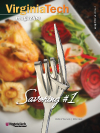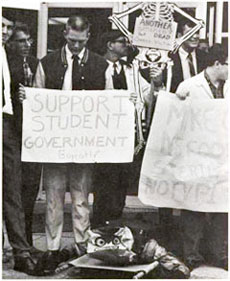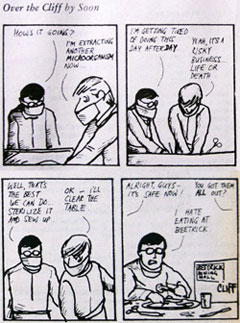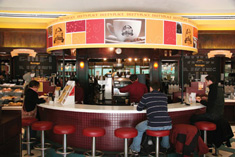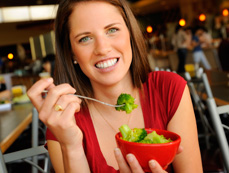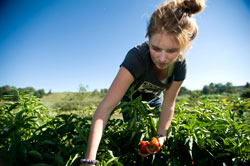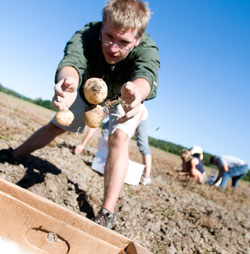 |
|
||||||
|
|
||||||||||||||||||||||||||||||||||||||||||||||||||||||||||||||||||||||||||||||||||||||||||||||||||||||||||||||||||||||||||||||||||||||||||||||||||||||||||||||||||||||||||||||||||||||||||||||||||||
In light of Virginia Tech Dining Services' award-winning food, outstanding customer service, innovative programming, and first-rate facilities, younger Hokie alumni may have trouble believing that complaints about campus dining were once as commonplace as cadet formations on the Drillfield. According to school histories written by Col. Henry D. Temple (industrial engineering '34) and by Professor Emeritus Duncan Lyle Kinnear, campus dining first suffered the slings and arrows of disgruntled students when Virginia Tech was but a greenhorn land-grant college charged with feeding an ever-hungry corps of cadets. For decades, campus meals were—literally and figuratively—a mess. In an oral history transcribed for a 1970 issue of Context, alumnus W. Purviance Tams Jr. (B.S., M.S. mechanical engineering 1902) recounts a spartan existence on the tiny Blacksburg campus, then named Virginia Agricultural and Mechanical College and Polytechnic Institute (popularly known as VPI, now Virginia Tech). The dining, it seems, was distinctly foul:
Organized by a student group that included Ray Smoot (English '69, M.S. education administration '71), now CEO of the Virginia Tech Foundation, the demonstration was anchored by a student nattily clad in a cockroach costume and carried around on a stretcher. Not that these goings-on require explanation, but the protest bemoaned reports of cockroaches in one of the dining facilities, particularly in one extra-juicy slice of pecan pie. To the students' delight, the boycott and protest received extensive attention in the local media—and earned a photograph in the annual Bugle of a student toting a cardboard skeleton with a sign proclaiming, "Another satisfied? but dead Owens victim." Despite the demonstration, dining on campus seems to have remained generally unsavory though not necessarily substandard. As Kinnear notes in his 1972 history, The First 100 Years, "any alumnus can testify that grumbling about the food and the way it is prepared has never been a monopoly belonging to any one class or period in Tech's history. In fact, it is a matter of record that every administration in VPI's first century had to face this problem at one time or another." Going forward, the university's second-century administrators must surely have chewed on that predicament for a while.Pie in the sky By most accounts, efforts to recast campus dining began in earnest in 1988, when a committee was formed to study Dining Services. That same year, the university welcomed a new president, James McComas, and a new vice president for student affairs, Tom Goodale. Because dining was a unit in Business Affairs, operations were geared purely toward keeping costs low, explained Vice President for Student Affairs Edward Spencer, who, at that time, was director of Housing and Residence Life. Students joked endlessly about the "elementary-school-style cafeteria," he recalled. The following year, Dining Services was moved under the administrative umbrella of the Division of Student Affairs, and Spencer was named director of Residential and Dining Programs. Both McComas and Goodale were "very interested in student quality of life," said Spencer, "and McComas asked me to turn the program around into something we can be proud of." And so changes began to occur. In 1990, Paul Fairbrook, a retired dean of the Culinary Institute of America, was brought in as interim director of Culinary Services, a new title within the unit. "He was well loved and provided a spark for the program," Spencer said. "He would personally give [food-preparation] tips to chefs and walk around with a thermometer in his pocket to check the temperature of the soup to make sure it was warm enough. Although he stayed for only eight or so months, he placed high emphasis on quality and doing things right." Fairbrook was followed by John Engstrom, whose three-year term was successful enough that Spencer still labels him "a marketing genius." During these transitions, the seedlings of a new dining culture had clearly begun to take root at Tech. Salad days The transformation of Dining Services into its current status as a nationally respected and highly decorated operation was guided by the sure hand of Rick Johnson, who was hired by Spencer in 1993 to serve as director of Dining Services and was later named director of Housing and Dining Services. In February, after 17 years at the university, Johnson departed for Duke University, where he was named assistant vice president of housing and dining. At Tech, Johnson brought a student-centered approach to campus dining, and his careful attention to quality, execution, industry trends, and student requests shepherded Dining Services to the very top. "Part of the pursuit of being best in class or best in the United States was the willingness to dream big and take risks," he said. "I'm proud that we had the vision, and we pursued it." On Johnson's watch, Dining Services became a genuine powerhouse, not only benchmarked by more than 50 colleges and businesses nationwide but also ranked No. 1 for "Best Campus Food" in both the 2008 and the 2010 editions of The Princeton Review. The rankings are especially gratifying because they are calculated from polls completed by students. Not surprisingly, current Hokies routinely report high overall satisfaction with the university's dining and consistently praise the variety of delicious and healthy food available on campus. Johnson, who was directly involved in the evolution and growth of the six campus dining facilities that house 11 dining operations, "made our students his priority, ensuring top-quality services for them," said Spencer. "Rather than being content with the industry standard, he consistently took an innovative approach, pushing the envelope and creating excellence." In a nod to the unit's collaborative mettle, Johnson explained he was "most proud that a group of dedicated managers and staff was able to begin work in 1993 to transform a large, somewhat middle-of-the-road dining program into the nation's No. 1 dining program, a cutting-edge enterprise against which peers nationwide benchmark their programs."
To that end, Dining Services sponsors a student advisory committee that meets monthly to generate ideas and works closely with the Student Government Association. In addition to encouraging students to fill out comment cards both on paper and online, the unit sponsors an annual forum called Table Talk Live, during which a manager occupies a special table in each dining center, allowing students to offer their feedback in person. Once the suggestions have been compiled, the most viable are implemented and posted online for review. (Go to www.studentprograms.vt.edu/dining/table_talk_live.php to see the latest.) Because of these forums, Dining Services has made changes to its menus, improved its facilities, and modified hours of operation to tailor their services to students' needs. The grandest result of student recommendations to date, however, is Turner Place, Dining Services' newest venue, for which ground was broken in February. Scheduled to open in fall 2012 behind McBryde Hall on the north, or academic, side of campus, the 800-seat facility was designed specifically to complement the existing dining centers on the south side of campus near the residence halls.Just as frequently, the unit looks within its own ranks for inspiration—and for the inside line on the student mindset. "At any given time, Dining Services employs 900 students," noted Faulkner, "so they are both our employment base and our spokespersons. They're living the life, so to speak, as students, and we welcome feedback directly from them as employees." Besides being responsive to students' requests and suggestions, the movers and shakers in Dining Services collectively point to the power of looking at market trends. This bold spirit, intrinsic to the university's climate of innovation and service, ensures that Tech students are eating the very best food in the very best venues. "In order to implement cutting-edge policies and practices, we frequently step back and note what's popular in the restaurant industry and evaluate the hot trends," Faulkner said. "The trick is to take these trends and develop a means to deliver them at a university serving thousands daily." Based on the breadth and scope of its successes during the past two decades, Dining Services has more than mastered the process. Cream of the crop If numbers are any indication, Tech's dining centers serve up skillfully prepared, scrumptious fare—from grab-and-go to made-to-order, homespun to fancy, American to international—that never breaks the bank. With approximately 1,500 employees supporting operations, Dining Services is the single largest employer on campus. Annually, some 6.2 million meals are served, generating sales of $43.5 million. Last year, more than 18,000 students purchased debit-style dining plans for use at any of the dining centers. "Major" plans range in price from $1,318 to $1,523 per semester, while "minor" plans are priced at $201 or $700. Most tellingly, more than half of the students who held dining plans in fall 2010 did not live on campus. "We are always very proud when we sell more dining plans to off-campus students than to on-campus students," said Dining Services' Assistant Director of Communications and Marketing Katie Gehrt (psychology '97, graphic design '02). "Campus residents are required to purchase meal plans, but they are optional for everyone else. We view this as a sign that we are doing a good job when so many students would choose a dining plan that's not required." If, on the other hand, variety is any indication, Hokies are eating high on the hog. The six dining facilities on campus—Dietrick Dining Center, Owens Dining Center, Shultz Dining Center, Squires Food Court, Vet Med Café, and West End Market—feature an array of restaurants, including both in-house specialty shops and well-known brand outlets, such as Au Bon Pain and Chick-fil-A, which typically sit atop the sales-volume charts in the college market. Not only do students praise the extensive food options, which include vegan, vegetarian, and kosher offerings, they are able to enjoy their meals in a number of different settings, each with its own ambiance. Indeed, diners can easily forget they're on a college campus in such locations as the Fighting Gobbler Sports Lounge or JP's Chop House, the crown jewel of West End Market, where more than 7,600 students are fed each day. However it's sliced or diced, dining on campus is worlds away from the "one line, one choice" venues that many alumni remember. Just how good is the food, then? The proof is in the pudding—and the whole Maine lobster and the London broil and the garlic mashed potatoes and the crème brûlée. Campus food at Virginia Tech is the best in the country.
|
|
|||||||||||||||||||||||||||||||||||||||||||||||||||||||||||||||||||||||||||||||||||||||||||||||||||||||||||||||||||||||||||||||||||||||||||||||||||||||||||||||||||||||||||||||||||||||||||||||||||
|
||||||||||||||||||||||||||||||||||||||||||||||||||||||||||||||||||||||||||||||||||||||||||||||||||||||||||||||||||||||||||||||||||||||||||||||||||||||||||||||||||||||||||||||||||||||||||||||||||||
|
|
||||||||||||||||||||||||||||||||||||||||||||||||||||||||||||||||||||||||||||||||||||||||||||||||||||||||||||||||||||||||||||||||||||||||||||||||||||||||||||||||||||||||||||||||||||||||||||||||||||


